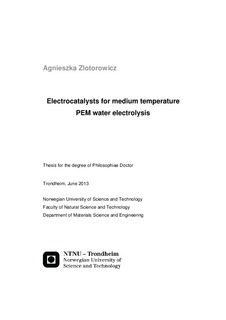| dc.description.abstract | The main subject of this PhD thesis is the fabrication and investigation the electrochemical behavior of anode catalysts appropriate for medium- temperature proton exchange membrane (PEM) water electrolysis (WE) operating in the range 100 oC through 200 oC. These catalysts were based on metal oxides, primarily IrO2 and its mixtures with some other oxides, and investigated as oxygen evolution electrocatalysts. A central research challenge in this project has been to understand the interaction between the anode catalyst and the solid polymer membrane electrolyte, and clarification of temperature effects.
Phosphoric acid is known as a suitable dopant to provide proton conductivity in membranes for high temperature for PEM fuel cells (FC) and WE. However, phosphates adsorb strongly on the catalyst, ultimately leading to its deactivation. Typical membrane for PEMFC and WE is Nafion, but is not mechanically stable at temperatures above ca. 100 oC. However, Nafion can be stabilized by addition of zirconium phosphate. Such membranes would be an alternative to the phosphate-based membranes provided that the zirconium phosphate does not have adverse effects on the catalytic activity of for example IrO2. On the basis of these considerations, we showed in this work that that zirconium hydrogen phosphate does not adsorb on or otherwise adversely affect the catalyst in terms of catalytic activity. In addition we even found some indications that the composite electrodes with zirconium hydrogen phosphate and Nafion can improve the utilization of iridium oxide.
To reduce the costs of expensive noble oxides (IrO2 and RuO2) and improve stability and activation of these catalysts novel electrocatalysts were synthesized and characterized for application in high-temperature PEM WE. We therefore also investigated composite oxides of iridium and niobium, of iridium and cerium, and of iridium, ruthenium and cerium.
The novel oxides are characterized using microscopic, XRD, XPS, and electrochemical techniques. The iridium-niobium and iridium-cerium oxides were synthesized by hydrolysis method and the solid solution oxides did not form.
Niobium oxide exhibits a pronounced effect as a catalyst additive for IrO2 catalysts. In terms of catalytic activity addition of up to 30 mol% Nb2O5 to IrO2 are acceptable, and the activity of the catalyst for the oxygen evolution reaction (OER) is still appreciable compared to iridium oxide at 80 ºC in PEM WE.
The electrochemical properties of the oxides showed that the addition of Nb2O5 to IrO2 particles had a highly beneficial effect at higher temperature (80 oC). Thus lower amounts of IrO2 can be used without appreciable loss of electrocatalytic activity, and with possibly improved anodic stability.
The addition of cerium oxide did not show significant performance improvements. However, addition of 10 mol% CeO2 to IrO2 is acceptable, and the activity of the catalyst for the oxygen evolution reaction (OER) is still appreciable compared to iridium oxide at 80 ºC in PEM WE.
Finally, the selection of substituted catalysts was tested at 150 oC in PEM WE with high-temperature membranes doped with phosphoric acid. The cross section of the MEA before and after the experiment shows that there is a good contact between the elctrocatalyst and the membrane. However, the thickness of the catalysts layer and that of the membrane after the experiments was reduced, indicating some loss of catalyst during operation. This was confirmed by an associated decrease in catalyst charge after the catalyst had been exposed to high potentials. Degradation of membrane as well as catalyst is observed. 10 mol% niobium oxide in iridium oxide showed higher electrocatalytic activity than the intrinsic IrO2 under these conditions. | nb_NO |

